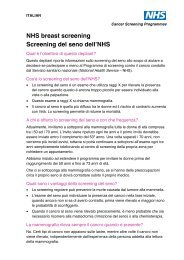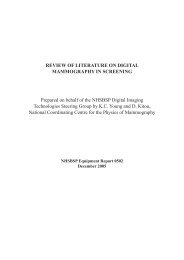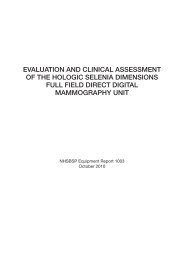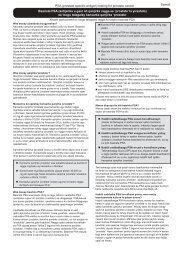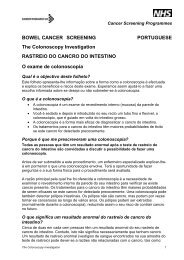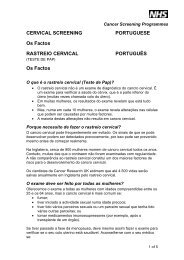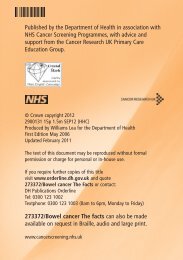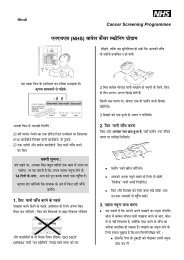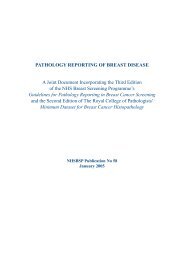reporting lesions in the nhs bowel cancer screening programme
reporting lesions in the nhs bowel cancer screening programme
reporting lesions in the nhs bowel cancer screening programme
You also want an ePaper? Increase the reach of your titles
YUMPU automatically turns print PDFs into web optimized ePapers that Google loves.
12 | Report<strong>in</strong>g Lesions <strong>in</strong> <strong>the</strong> NHS Bowel Cancer Screen<strong>in</strong>g Programme<br />
4. ADENOCARCINOMA<br />
4.1 Def<strong>in</strong>ition of <strong>in</strong>vasion<br />
The recommended def<strong>in</strong>ition of an adenocarc<strong>in</strong>oma is <strong>the</strong> one that is <strong>in</strong> everyday use with<strong>in</strong> <strong>the</strong> UK<br />
of <strong>in</strong>vasion of neoplastic cells through <strong>the</strong> muscularis mucosae <strong>in</strong>to <strong>the</strong> submucosa of <strong>the</strong> <strong>bowel</strong><br />
wall.<br />
This def<strong>in</strong>ition does not allow for <strong>the</strong> diagnosis of <strong>in</strong>tramucosal carc<strong>in</strong>oma, and such cases should<br />
be considered to be high grade dysplasia. Also, <strong>the</strong> def<strong>in</strong>ition does not allow comparison with<br />
Japanese series, <strong>in</strong> which a diagnosis of carc<strong>in</strong>oma can be made on cases of high grade dysplasia<br />
without <strong>in</strong>vasion, but it is compatible with US and European literature.<br />
The TNM classification of colorectal tumours is given <strong>in</strong> Appendix 1, and <strong>the</strong> relevant SNOMED<br />
codes are given <strong>in</strong> Appendix 2.<br />
4.2 Epi<strong>the</strong>lial misplacement<br />
Epi<strong>the</strong>lial misplacement of adenomatous epi<strong>the</strong>lium <strong>in</strong>to <strong>the</strong> submucosa of a polyp is a well recognised<br />
phenomenon. 13 It is commonly seen <strong>in</strong> prolaps<strong>in</strong>g polyps <strong>in</strong> <strong>the</strong> sigmoid colon. Experience<br />
from <strong>the</strong> pilot sites suggests that this will be one of <strong>the</strong> most difficult areas of pathological diagnostic<br />
practice <strong>in</strong> <strong>the</strong> NHS BCSP. These sigmoid colonic polyps are particularly prone to <strong>in</strong>flammation and<br />
ulceration, features which tend to enhance <strong>the</strong> dysplastic changes present. When associated with<br />
epi<strong>the</strong>lial misplacement, <strong>the</strong> potential for misdiagnosis of early carc<strong>in</strong>oma and <strong>the</strong> overall diagnostic<br />
difficulties become much greater.<br />
4.3 Early adenocarc<strong>in</strong>omas (pT1)<br />
Tumours that <strong>in</strong>vade <strong>the</strong> muscularis propria (pT2) usually require fur<strong>the</strong>r surgery and should be<br />
staged accord<strong>in</strong>g to <strong>the</strong> <strong>cancer</strong> m<strong>in</strong>imum dataset.<br />
pT1 tumours will provide many difficulties <strong>in</strong> <strong>the</strong> <strong>programme</strong>, and <strong>the</strong> current evidence base for<br />
<strong>the</strong>ir management is poor. Thus as a priority we have chosen to concentrate on generat<strong>in</strong>g a firm<br />
evidence base for management. This will require a limited number of extra assessments that we will<br />
<strong>the</strong>n ref<strong>in</strong>e on <strong>the</strong> basis of <strong>the</strong> data emerg<strong>in</strong>g from <strong>the</strong> pilot sites and <strong>the</strong> <strong>programme</strong>. In particular,<br />
substag<strong>in</strong>g and differentiation grad<strong>in</strong>g are addressed.<br />
4.4 Substag<strong>in</strong>g<br />
In pT1 tumours, <strong>the</strong> frequency of lymph node metastasis <strong>in</strong> sessile tumours that <strong>in</strong>volve <strong>the</strong><br />
superficial, middle and deep thirds of <strong>the</strong> submucosa (so-called Kikuchi levels sm1, sm2 and sm3<br />
respectively 6 ) has been reported to be 2%, 8% and 23% respectively. 7<br />
In polypoid <strong>lesions</strong>, Haggitt et al 5 identified <strong>the</strong> level of <strong>in</strong>vasion <strong>in</strong>to <strong>the</strong> stalk of <strong>the</strong> polyp as<br />
be<strong>in</strong>g important <strong>in</strong> predict<strong>in</strong>g outcome and found that ‘level 4’ <strong>in</strong>vasion, <strong>in</strong> which tumour extended<br />
beyond <strong>the</strong> stalk of <strong>the</strong> polyp <strong>in</strong>to <strong>the</strong> submucosa but did not <strong>in</strong>vade <strong>the</strong> muscularis propria, was<br />
an adverse factor.<br />
NHS BCSP September 2007



